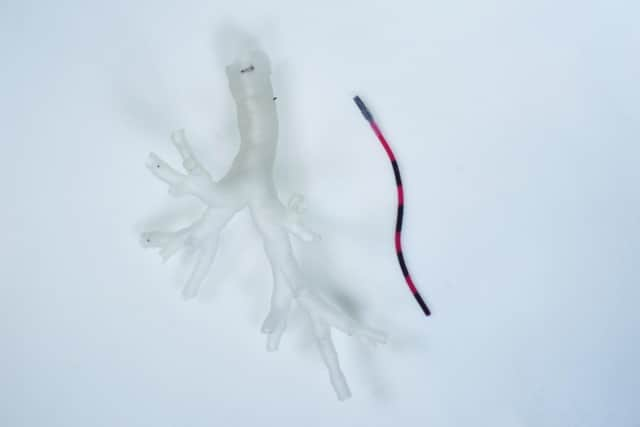Scientists in Leeds design robot that can reach small tubes in lungs to deliver cancer treatment
and live on Freeview channel 276
Known as a magnetic tentacle robot, it measures just 2 millimetres in diameter, about twice the size of the tip of a ballpoint pen, scientists said.
Magnets on the outside of the patient will be used to guide the magnetic tentacle robot into place.
Advertisement
Hide AdAdvertisement
Hide AdThe device has been developed by a team of engineers, scientists and clinicians based at the STORM Lab at the University Leeds, which is pioneering the use of robotic systems to assist in endoscopy and catheter procedures, where a fine tube is inserted into body.
The researchers have published their findings in the journal Soft Robotics.
The proof of concept they have developed was based on laboratory tests involving a 3D replica of a bronchial tree modelled from anatomical data.
The next phase of the research will investigate the effectiveness of the device in navigating lungs taken from a cadaver.
Advertisement
Hide AdAdvertisement
Hide Ad

Currently, doctors use an instrument called a bronchoscope to carry out an examination of the lungs and air passages.
The procedure involves passing a flexible tube-like instrument, about 3.5 to 4 millimetres in diameter, through the nose or mouth and into the bronchial passages.
Because of its size, the bronchoscope can only travel as far as the upper levels of the bronchial tree.
To delve deeper into the lungs, a catheter or fine tube – measuring about 2 millimetres in diameter – is passed through the bronchoscope and then on and into the smaller tubes of the lungs.
Advertisement
Hide AdAdvertisement
Hide AdBut doctors are limited in how they can move a bronchoscope, making it difficult to navigate the instrument and the catheter to where they are needed.
The magnetic tentacle robot, however, has been developed to be much more manoeuvrable and uses a robotic guidance system that is personalised for each procedure.
Professor Pietro Valdastri, Director of the STORM Lab, who supervised the research, said: “A magnetic tentacle robot or catheter that measures 2 millimetres and whose shape can be magnetically controlled to conform to the bronchial tree anatomy can reach most areas of the lung, and would be an important clinical tool in the investigation and treatment of possible lung cancer and other lung diseases.
“Our system uses an autonomous magnetic guidance system which does away for the need for patients to be X-rayed while the procedure is carried out.”
Advertisement
Hide AdAdvertisement
Hide AdMagnets mounted on robotic arms on the outside of the patient are used to guide the device in a process that would be tailor-made for each procedure.
The route through the bronchial tree will be planned from pre-operative scans of a patient’s lungs and programmed into the robotic system. As the magnets outside of the patient move, they develop forces on the magnetic particles in the segments of the catheter, causing them to change shape or direction – enabling the robot to be manoeuvred through the lungs and to a site of a suspicious lesion.
External magnets manoeuvre the magnetic tentacle robot past a series of obstacles.
Once at the target location, the robot is used to take a tissue sample or deliver treatment.
Advertisement
Hide AdAdvertisement
Hide AdDr Cecilia Pompili, research fellow and thoracic surgeon at Leeds Teaching Hospitals NHS Trust and a member of the research team, said: "This new technology will allow to diagnose and treat lung cancer more reliably and safely, guiding the instruments at the periphery of the lungs without the use of additional X-rays."
It may be several years before “magnetic tentacle” technology is available in a hospital setting.
The STORM lab at the University of Leeds is revolutionising the technology used in endoscopic and catheter investigations.
It has created a protype of a low-cost endoscope – used to investigate the upper gastrointestinal tract – which could be used in low to middle income countries where lack of access to expensive equipment is hampering screening programmes.
Advertisement
Hide AdAdvertisement
Hide AdMagnetic technology is also at the heart of a robotic colonoscopy system that is easier for staff to operate and kinder for patients.
The STORM lab is part of the Leeds Centre for Cancer Research, which was launched earlier in the year.
Support the YEP and become a subscriber today. Enjoy unlimited access to local news and the latest on Leeds United, With a digital subscription, you see fewer ads, enjoy faster load times, and get access to exclusive newsletters and content. Click here to subscribe.
Comment Guidelines
National World encourages reader discussion on our stories. User feedback, insights and back-and-forth exchanges add a rich layer of context to reporting. Please review our Community Guidelines before commenting.
